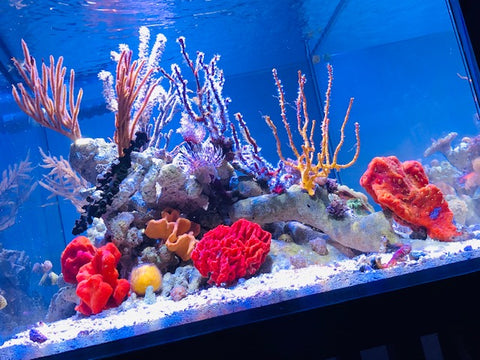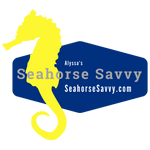Gorgonian Corals in a Seahorse Aquarium


Gorgonian Corals in a Seahorse Aquarium
Gorgonians corals are colonial soft corals. There are many different species and varieties of Gorgonian corals readily available. These easy to keep soft corals come in a variety of shapes, colors, and forms. Most common are the branching Gorgonians but there are also encrusting varieties. Seahorses are sit and wait predators and masters of camouflaging with their color changing ability. Being sit and wait predators, they will use their prehensile tail to grasp "hitch" to objects in their environment. Many Gorgonian species are found in some species' natural environment including H. erectus. These uniquely shaped corals make perfect natural seahorse hitching posts in the home aquarium and really create a natural display in your aquarium. They are one of our favorite types of corals and go well in any reef aquarium too!


Purple Knobby and Giant Slit Pore Gorgonians
Placement in the Aquarium and Care
Like the majority of soft corals, Gorgonian corals are seahorse safe meaning they will not sting or harm your seahorses. The different species of Gorgonians can irritate each other so giving them their own space and not allowing them to touch in the aquarium is recommended.
Gorgonians do best with moderate to slightly higher flow. A common misconception is seahorses need low flow. This is outdated and misinformation. Healthy captive bred seahorses like seahorses from our farm can handle a moderate to slightly higher flow and we highly encourage this. Having proper flow is key to long term success in keeping the aquarium turned over, clean, providing good gas exchange and your seahorses healthy. Low flow is not good for any saltwater aquarium! If you have any powerheads in the aquarium you will need to keep them covered to prevent injury to your seahorses.


How to Attach Gorgonians to Your Liverock
At Seahorse Savvy, we offer a variety of Gorgonians to keep with your captive bred seahorses. Our Gorgonians often come attached to a ceramic coral frag plug. This plug can be placed into a hole in your liverock. One can also use Coral Glue to attach the plug to the rockwork to help keep the Gorgonian secure and in place.
If you do not have a hole in the rockwork or perhaps do not like seeing the frag plug in your aquarium, you can remove the Gorgonian coral from the ceramic coral frag plug. Gorgonian corals have a "stem" internal which you will see when you remove the coral from the plug. This is most often brown in coloration. We recommend dropping the coral glue on this stem base outside of the aquarium and placing the base onto the rockwork in the aquarium where you wish. It helps to find a little crevice in the rock to place the base in. Once the glue hits the water it will start to set and have an external film. It helps to twist the base on the rock where you wish to place the coral to help break open this drying film. This will help the coral stick to the rock better. Many Gorgonians are going to be top heavy and will take some practice to get the hang of placing them in the aquarium. It may also help to lean another piece of rock on the Gorgonian for a few hours to keep it upright while the glue fully sets.


Photosynthetic and Nonphotosynthetic Gorgonians
There are both photosynthetic and nonphotosynthetic Gorgonian species. When browsing our Gorgonian varieties you will see whether or not they are photosynthetic or nonphotosynthetic species. The majority of the Gorgonians we offer are photosynthetic meaning their get their energy from light. For this reason, having reef capable lighting is needed to properly keep these corals. Photosynthetic Gorgonians tend to be the easier verities to keep and are hardy.
Commonly available photosynthetic Gorgonian species include:
- Muricea elongate-Common names Rusty or Orange Spiny Gorgonian
- Muriceopsis flavida-Common names Purple Brush Gorgonian
- Pterogorgia citrina-Green Lace Gorgonian
- Pterogorgia anceps-Purple Ribbon or Purple Flat Blade Gorgonian
- Pseudopterogorgia bipinnata-Golden Plume Gorgonian. There is also a purple variety, Purple Plume Gorgonian
- Psuedopterogorgia elisabethae-Purple Frilly Gorgonian
- Eunicea sp.-Purple Knobby Gorgonian, another one of our favorite varieties!
- Plexaura flexuosa-Purple Candelabra Gorgonian


We do offer some nonphotosynthetic Gorgonian varieties. Our most popular is our Red and Yellow Finger Gorgonians, Diodogorgia nodulifera. This is a Caribbean native species with bright color and beautiful bright white polyps. These are absolutely gorgeous. We find this species to be one of the easiest to keep nonphotosynthetic Gorgonian corals. Since they do not get energy from light, you will need to feed them. At our farm we are successful with keeping them by feeding them several times a week minimum. We are feeding them our farm recipe enriched Artemia nauplii, PhycoPure ReefBlend, and a variety of other small coral foods. Photosynthetic Gorgonians will benefit from feeding as well. You want their polyps to be out during feeding time.


Water Parameters
See the chart below for recommended seahorse aquarium parameters. These are the parameters we recommend for most of the larger species including, H. erectus, H. reidi, H. kuda and more. Gorgonian corals will also do well at these same parameters including the lower 70-74 F temperature range we recommend. We highly recommend using RODI water to mix your saltwater for your aquarium. Maintaining high water quality, having proper filtration, doing regular water changes and having good husbandry are key to successfully keeping your seahorses and tank-mates.
|
Parameter |
Recommended level |
|
Specific Gravity |
1.020-1.025 |
|
pH |
8.1-8.4 |
|
alkalinity |
8-12 Dkh |
|
Ammonia (NH3) |
UNDETECTABLE |
|
Nitrite (NO2) |
UNDETECTABLE |
|
Nitrate (NO3) |
(IDEALLY UNDETECTABLE) <25 PPM |
|
Phosphate (PO4) |
(IDEALLY UNDETECTABLE) <0.2 PPM |
|
Calcium |
350-450 PPM |
|
Magnesium |
1250-1350 PPM |
|
Temperature |
70-74 F |

Thank you for reading. Our captive bred seahorses are hardy and a lot of fun to keep. If you have any questions about the caring for our seahorses please contact us. We want you to be a successful keeper and are more than happy to help.


Tank Mates for Captive Bred Seahorses-Saltwater Fish
https://seahorsesavvy.com/blogs/news/tank-mates-for-seahorses-fish
Tank-mates for Captive Bred Seahorses-Live Corals
https://seahorsesavvy.com/blogs/news/tank-mates-for-captive-bred-seahorses
How to Sex a Seahorse
https://seahorsesavvy.com/blogs/news/how-to-sex-a-seahorses
Training Your Seahorse to Feed at a Feeding Station
https://seahorsesavvy.com/blogs/news/training-your-seahorse-to-feed-at-a-feeding-station
Acclimating Your New Seahorse to Your Aquarium
https://seahorsesavvy.com/blogs/news/acclimating-your-new-seahorse-to-your-aquarium
Seahorse Savvy-Reidi x Erectus Hybrid Seahorses
https://seahorsesavvy.com/blogs/news/seahorse-savvy-reidi-x-erectus-hybrid-seahorses
Piebald Seahorse Gallery and Info
https://seahorsesavvy.com/blogs/news/piebald-seahorse-gallery
Encouraging Brighter Seahorse Coloration
https://seahorsesavvy.com/blogs/news/promoting-brighter-seahorse-coloration
Rinsing Your Frozen Foods for Your Seahorses
https://seahorsesavvy.com/blogs/news/rinsing-your-frozen-foods-for-your-seahorses
